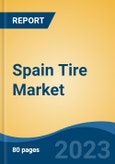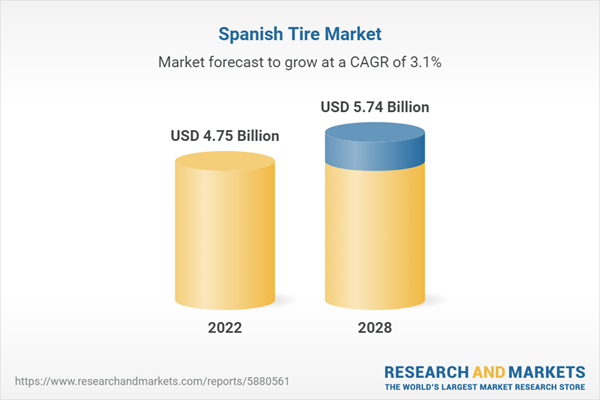Speak directly to the analyst to clarify any post sales queries you may have.
10% Free customizationThis report comes with 10% free customization, enabling you to add data that meets your specific business needs.
Key Market Drivers:
Vehicle Sales and Ownership: The demand for tires is directly influenced by the number of registered vehicles in Spain. As the vehicle fleet grows, there is a corresponding increase in the need for replacement tires. New vehicles typically come equipped with original equipment tires, and as these tires wear out over time, consumers seek replacements. Therefore, vehicle sales and ownership are crucial drivers of tire market growth.
Economic Growth and Consumer Spending:
Economic stability and growth have a direct impact on consumer spending behavior, including purchases of vehicles and related products, such as tires. During periods of economic expansion, consumers generally have more disposable income, leading to increased vehicle purchases. A strong economy can result in higher consumer confidence, encouraging people to invest in new vehicles or upgrade to better-quality tires.
Technological Advancements
Tire manufacturers continually invest in research and development to introduce advanced tire technologies. Innovations, such as run-flat tires that can continue operating even after a puncture, all-season tires suitable for various weather conditions, and smart tire monitoring systems that provide real-time data on tire performance, safety, and efficiency, attract consumers seeking enhanced driving experiences and safety features.Government Regulations
The Spanish government, like other authorities worldwide, implements regulations and standards to ensure tire safety and reduce environmental impact. Such regulations may include labeling requirements, rolling resistance standards to promote fuel efficiency, and noise emission limits. Compliance with these regulations drives tire manufacturers to develop eco-friendly and sustainable tire solutions, meeting the demand for environmentally conscious products.Seasonal Demand
Spain experiences seasonal changes, especially during winter when adverse weather conditions can affect road safety. Consequently, there is an increased demand for specialized winter tires, which offer better traction and performance on icy and snowy roads. During the summer months, all-season tires may be preferred for their versatility in various weather conditions.Replacement Tire Demand
As vehicles age and accumulate mileage, their tires wear out and require replacement. The replacement tire market constitutes a substantial portion of tire sales in Spain. Consumers often seek tires that offer good value for money, long tread life, and performance characteristics suitable for their driving habits.Key Market Challenges:
Sustainability and Environmental Concerns:
Increasing environmental awareness has led to a demand for more sustainable and eco-friendly products, including tires. The tire industry faces pressure to adopt environmentally friendly practices, such as using recycled materials, reducing tire waste, and improving tire recycling processes. Adhering to these sustainability standards may require investments in research and development and changes in manufacturing processes.
Economic Volatility:
Economic fluctuations and uncertainties can impact consumer spending on vehicles and related products like tires. During economic downturns, consumers may delay non-essential purchases, including tire replacements, leading to reduced demand in the market. Maintaining stability during economic downturns can be challenging for tire manufacturers and retailers.
Regulatory Compliance:
Adhering to a complex web of local, national, and international regulations can be demanding for tire manufacturers. Compliance with safety standards, labeling requirements, and environmental regulations can add administrative burdens and costs to businesses.
Shift in Consumer Preferences:
Changing consumer preferences and trends can present challenges for tire manufacturers. For instance, a shift in demand towards eco-friendly tires or tires with specific performance attributes may require adjustments in production and marketing strategies to meet evolving consumer needs.
Key Market Trends:
Growing Demand for Eco-Friendly Tires:
With increasing awareness of environmental issues, consumers are becoming more conscious of their carbon footprint. This has led to a growing demand for eco-friendly tires that help reduce fuel consumption and greenhouse gas emissions. Eco-friendly tires typically have lower rolling resistance, which means they require less energy to move, leading to improved fuel efficiency. Tire manufacturers are investing in research and development to develop tire compounds and tread designs that strike a balance between eco-friendliness and performance.
Digitalization and Online Tire Sales:
The digital revolution has transformed the way consumers shop for tires. Online tire sales platforms have emerged, providing consumers with the convenience of browsing and comparing tire options from the comfort of their homes. These platforms also offer detailed product information, customer reviews, and tire recommendations based on vehicle specifications and driving preferences. Digitalization has enabled tire manufacturers and retailers to reach a broader audience and offer personalized tire solutions tailored to individual needs.
Segmental Insights
Vehicle Type Insights
In Spain, the major vehicle type that dominates the tire market is passenger cars. Passenger cars are the most prevalent vehicles on Spanish roads, accounting for a significant portion of the country's total vehicle fleet. As a result, the demand for tires for passenger cars is substantial and plays a crucial role in shaping the tire market landscape. One of the primary reasons for the dominance of passenger cars in the tire market is the high number of passenger car registrations in Spain. With a large population and a strong automotive culture, passenger cars are the preferred mode of transportation for most individuals and families. As the number of registered passenger cars increases over time, there is a corresponding rise in the demand for tires to replace worn-out or damaged tires. Moreover, passenger cars have diverse tire requirements due to the wide range of vehicle makes and models available in the market. Tire manufacturers respond to this demand by producing a broad selection of tire options tailored to different passenger car types and driving preferences. Consumers can choose from various tire sizes, tread patterns, and performance characteristics, allowing them to find tires that best suit their specific vehicles and driving habits. In addition to new passenger car sales, the aftermarket tire demand for these vehicles is also substantial. As passenger cars age, their tires wear out and require replacement. This steady need for replacement tires further contributes to the dominant market share of passenger cars in the tire industry. Furthermore, passenger cars' popularity also drives innovation in tire technology. Tire manufacturers invest in research and development to produce tires that enhance passenger car performance, safety, and fuel efficiency. The continuous pursuit of improvements and new features, such as all-season tires, run-flat tires, and eco-friendly options, keeps the market competitive and responsive to changing consumer needs.Tire Construction Type Insights
In Spain, the tire type with the major market share is radial tires. Radial tires have gained widespread popularity and dominance in the Spanish tire market due to their numerous advantages over bias tires. Radial tires offer superior performance, comfort, and fuel efficiency, making them the preferred choice for most vehicles in the country. One of the key factors contributing to the dominance of radial tires is their construction. Radial tires have a unique design that includes layers of steel belts running perpendicular to the tire's direction of travel. This construction allows for better stability, improved grip on the road, and reduced rolling resistance, leading to enhanced fuel efficiency. As a result, consumers are increasingly choosing radial tires for their passenger cars, light commercial vehicles, and even some heavy commercial vehicles. Radial tires also provide a more comfortable ride compared to bias tires. The flexible sidewalls of radial tires absorb road shocks and vibrations, resulting in a smoother driving experience. This added comfort is particularly appealing to consumers who prioritize a comfortable ride quality, especially for long journeys or daily commutes. Furthermore, radial tires offer excellent traction on both dry and wet road surfaces, making them suitable for various weather conditions. This versatility is highly valued by consumers, especially in regions with diverse weather patterns like Spain.Regional Insights:
Catalonia, a region located in the northeast of Spain, holds the highest tire market value in the country. This is due to its robust automobile industry, high consumer purchasing power, and strategic geographical location, which facilitates accessibility and trade. Its capital, Barcelona, is home to several major car manufacturers, further bolstering the region's tire market.
More specifically, Catalonia's dominance in the tire market can be attributed to a combination of factors. Firstly, the region's strong automotive sector directly influences the tire market. Several high-profile car manufacturers, including SEAT and Nissan, have production plants in Catalonia, particularly in and around Barcelona. This local presence of auto manufacturers creates a high demand for tires, driving up their market value.
Secondly, Catalonia's residents have relatively high purchasing power compared to other regions of Spain. With a GDP per capita higher than the EU average, Catalans have the financial ability to invest in quality automotive parts, including tires. This economic factor contributes significantly to the region's high tire market value.
Key Market Players
- Michelin España Portugal S.A.
- Continental Tires España, S.L.
- Pirelli Neumaticos S.A.
- Nokian Tyres P.L.C.
- Bridgestone Hispania S.A.
- Goodyear Dunlop Tires España, S.A
- Hankook España, S.A.
- Yokohama Iberia S.A.
- Belshina Joint Stock Company
- Cooper Tire & Rubber Company España SL
Report Scope:
In this report, the Spain Tire Market has been segmented into the following categories, in addition to the industry trends which have also been detailed below:Spain Tire Market, By Vehicle Type:
- Passenger Car
- Light Commercial Vehicle
- Medium & Heavy Commercial Vehicle
- Off the Road Vehicle
- Two-Wheeler
- Three-Wheeler
Spain Tire Market, By Demand Category:
- OEM
- Replacement
Spain Tire Market, By Tire Construction Type:
- Radial
- Bias
Spain Tire Market, By Region:
- North Spain
- Madrid, Extremadura & Castilla
- Aragon & Catalonia
- Andalusia, Murcia & Valencia
Competitive Landscape
Company Profiles: Detailed analysis of the major companies present in the Spain Tire Market.Available Customizations:
Spain Tire market report with the given market data, the publisher offers customizations according to a company's specific needs.This product will be delivered within 1-3 business days.
Table of Contents
Companies Mentioned
- Michelin España Portugal S.A.
- Continental Tires España, S.L.
- Pirelli Neumaticos S.A.
- Nokian Tyres P.L.C.
- Bridgestone Hispania S.A.
- Goodyear Dunlop Tires España, S.A.
- Hankook España, S.A.
- Yokohama Iberia S.A.
- Belshina Joint Stock Company
- Belshina Joint Stock Company
Table Information
| Report Attribute | Details |
|---|---|
| No. of Pages | 80 |
| Published | September 2023 |
| Forecast Period | 2022 - 2028 |
| Estimated Market Value ( USD | $ 4.75 Billion |
| Forecasted Market Value ( USD | $ 5.74 Billion |
| Compound Annual Growth Rate | 3.1% |
| Regions Covered | Spain |
| No. of Companies Mentioned | 10 |









